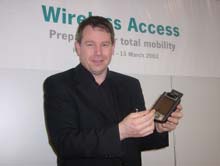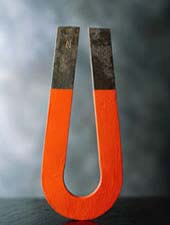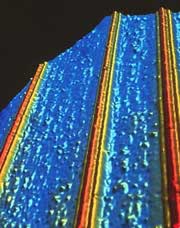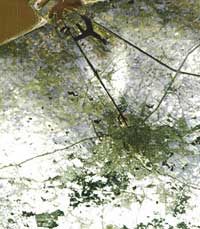
An inventive idea from Dr Chris Solomon of the School of Physical Sciences at the University of Kent at Canterbury (UKC) has beaten top International competition and won first prize in the prestigious European Digital Information Contents (DICON) competition.
Dr Solomon who has an active research programme in forensic imaging and a longstanding interest in the computational modelling, encoding and recognition of the human face said: `I was truly impressed by the quality of some of the prese

In a joint project between the Technology Foundation STW and the energy agency Novem at Utrecht University, researchers have developed new silicon layers which are more stable and cheaper than the present amorphous silicon layers. The electronic properties of the present layers in laptop screens and solar cells deteriorate if the material is under ‘stress’, for example due to sunshine or a voltage.
Flat-panel displays and solar cells have a substrate of glass or plastic, which is coated with

+++ EURESCOM for the first time demonstrates seamless access with a PDA. +++
Premiere at the EURESCOM workshop `Wireless Access` in Heidelberg on 12 March: The EURESCOM project on `Bluetooth Access` presented the first PDA, which can seamlessly connect to different access networks, like LAN, Bluetooth, Wireless LAN, and GPRS.
In co-operation with the software company Birdstep from Norway and access point supplier Patria Ailon from Finland, the European project team implement

New algorithm exploits community structure of the web.
The web has spontaneously organized itself into communities. A new search algorithm that pinpoints these could help surfers find what they want and avoid offensive content.
Page builders can link anywhere. But they don’t, Gary Flake, of the NEC Research Institute in Princeton, and his colleagues have found. Instead, pages congregate into social groups that focus most of their attention on each other.
Web dir

The research group Multimedia Lab of the Ghent University (Belgium) succeeded in putting the first MPEG-21 application online. MPEG-21 technology is the most recently developed technology for multimedia applications. After the MPEG-1, -2, -4, and MPEG-7 standards, MPEG-21 is currently considered to be one of the most promising new standard in the field of multimedia systems and applications.
The research activities of Multimedia Lab at Ghent University, Belgium (Department of Electron

Community and Member Feedback Shapes New Royalty-Free Draft
The World Wide Web Consortium (W3C) today published a revised Patent Policy Working Draft which is based on strong, explicit commitments to producing Royalty-Free (RF) specifications. To achieve the goal of producing Royalty-Free specifications, the draft requires all who participate in the development of W3C Recommendations to make any essential patents they hold available for free.
The option which would have permi

Light-sensitive ’plastic’ magnets could replace your hard drive.
A ’plastic’ magnet that responds to light could lead to new ways of storing and reading large amounts of computer data. Light would be used to store information in cheap, fast and high-capacity ’magneto-optic’ memories.
The light-switchable magnet is the first to be made from organic (carbon-based) molecules. This means its discoverers, Arthur Epstein of Ohio State University in Columbus and Joel Miller of the

A team of physicists in the United States has made an important step towards making quantum computing a reality. Research into a new type of noiseless quantum information bit, or qubit, is published today in the joint Institute of Physics and German Physical Society journal, New Journal of Physics.
At a sub-atomic scale the laws of quantum physics lead to strange new properties of matter. For several years physicists have been trying to exploit this quantum weirdness to build a new type of `

Joint work with IETF produces XML-based solution for digital signatures, foundation for Secure Web services
The World Wide Web Consortium (W3C) has issued XML-Signature Syntax and Processing (XML Signature) as a W3C Recommendation, representing cross-industry agreement on an XML-based language for digital signatures. A W3C Recommendation indicates that a specification is stable, contributes to Web interoperability, and has been reviewed by the W3C Membership, who favor its widespread

Is it possible to combine a three-dimensional wire model of a face with real pictures of the same face? And is it possible to get the computer that is forming the new image to follow the face even when the person in question makes sudden movements or partially covers her face with her hand? These are a couple of the research questions for the Image Coding Group at the Department of Electrical Engineering at Linköping University in Sweden. The aim is to find a new technology for information-efficient

Several years ago an “electronic nose” was developed at Linköping University in Sweden. It was based on a number of different gas sensors and programmed to differentiate between various substances in air. This nose is now being joined by a corresponding sensor for fluids, the “electronic tongue.” The principle behind the “electronic tongue” is that a number of electrodes are submerged in the fluid. When a current is turned on across the electrodes the response varies depending on the liquid’s content

Wires one-millionth of a millimetre wide change composition along their length.
Wires one-millionth of a millimetre wide that change chemical composition along their length, just as fruit pastilles change flavour along a packet, have been grown in the United States. These multi-flavoured nanowires can act as miniature bar-codes, diodes and light sources.
Conventional microelectronics components are etched into flat layers of semiconducting material. Charles Lieber and collea

Many Europeans are now learning to deal with a new currency. But also cash dispensers and cigarette machines must distinguish clearly between euros, the old currencies and counterfeit money. A miniature computer now checks the coins by means of digital image processing.
For users of the new European currency, having adequate safeguards against forgery is a matter of great importance. The paper money incorporates features such as holograms, watermarks, a security thread, and embossed text to

A technique used by academics to analyse poetry may soon help industry to find out whether computer safety systems really ARE safe. In a novel example of interdisciplinary academic work, English literature meets computing science in an project to design a decision-making framework for the safety industry.
Newcastle University researcher Jim Armstrong, who holds a first degree in English Literature and a PhD in Computing Science, is investigating how the technique ‘deconstruction’ – usually

The University of Abertay Dundee has been named as a key member of an international project, to develop new ways of delivering computer applications via the internet.
The 2.8 million euros (£1.8 million) scheme will see academics and business people from across Europe work together to develop the technology, which is set to revolutionise the way in which computer applications are accessed, delivered and updated for users across the globe.
Abertay University, the only UK body invited

ESA’s new micro-satellite PROBA has captured its first test images of the Earth’s surface using its small but powerful optical instrument, just two months after its launch from the Indian equator.
PROBA (Project for On Board Autonomy), the size of a small box and in orbit 600 km above the Earth’s surface, has provided scientists with its first detailed environmental images thanks to CHRIS – a Compact High Resolution Imaging Spectrometer – the main payload on the 100 kg European spacecraft.